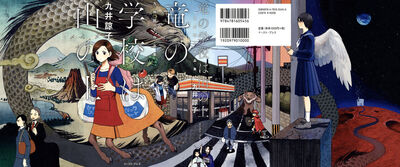Justified In The End
Ryuu no Gakkou wa Yama no Ue Kui Ryouko Works
By Ryōko Kui

21 May, 2025
0 comments
Ryoko Kui’s 2011 Ryuu no Gakkou wa Yama no Ue Kui Ryouko Works ( The School of Dragons is on the Mountain — Ryoko Kui Works) is a collection of ten short spec-fic stories, some which are connected by the question “what follows a successful quest?”
A few of the stories appear to be straightforward fantasy (although that’s cast in doubt by an unexpected revelation), while others could be science fiction.
But… Kui brings an almost hard SF, pragmatic perspective to her tales, irrespective of apparent genre. Her Beast-lord stories begin where many authors end. She is more interested in the consequences of victory than the struggle to overthrow the evil overlord. Likewise, where other author might muse whimsically about winged girls or centaurs, Kui focuses on the practical issues faced by someone with wings in a Japan festooned with overhead wires. Or on the problem of coexistence between humans (who don’t like to work, but need to be employed to survive) and centaurs (who are incapable of leisure, even though their lifestyle costs them decades of life).
The stories are nicely done and this was a diverting way to spend an afternoon. If I understand correctly, this was the author’s debut professional manga, which makes me want to track down the amateur work that preceded this.
Too bad there does not appear to be a legal English translation of this collection.
“Untitled One”
A hero who helped vanquish the Beast-lord struggles to come to terms with the fact that the legacy of his heroism is strife and misery.
“Untitled Two”
A wandering story teller entertains children with the tale of a cursed beast, the beautiful lady he kidnapped, and the fate that befell the beast. Not all of the audience is pleased.
“Untitled Three”
A jaded, cynical hero leads an occupation force to the Beast-lord’s abandoned stronghold. The castle holds deadly secrets — but how to convince a bitter man to share what he knows?
“Control”
Well-meaning cosmic charity delivers unexpected but not entirely awful results.
“A Bride for Daikon Mountain”
A godless village seeks a god to protect the village, much to the distress of the young woman who is in love with the man willing to serve as the required human sacrifice.
“A Modern Fairy Tale”
Centaurs and humans struggle to reconcile centaurs’ relentless work ethic with humanity’s desire to be employed.
The issue is: why would anyone hire a human if a centaur were available, given that centaurs are inherently incapable of sloth? One could argue that the issue should be how to provide centaurs with the ability to take it easy, given that their current habits kill them twenty years before they would have died if they were humans?
“A School for Angels”
A young man tries to advise his winged friend, who must choose between staying in the Japan she knows at the cost of losing her ability to fly, or retaining the ability to fly at the cost of emigrating to distant USA1. Almost too late, he realizes he is interrogating the question from the wrong perspective.
“The Dragon’s School is On Top of the Mountain”
Academics struggle with a seemingly insurmountable challenge: how to convince Japan to protect its dwindling dragon population when modern society has no use for them?
Dragons don’t seem to be magical. They belong to a lineage of hexapods. Some of these hexapods used two of their limbs as wings; other hexapods had two vestigial limbs.
We never seen dragons and centaurs in the same story, but I couldn’t help wondering if they were related.
“The Experiment”
A shiftless man finds his true purpose in life.
This story could have been written by Sheckley.
“The Money Grubber”
A gourmet savors unusual food.
This could also have been written by Sheckley.
1: Canada would be a better choice. USA delenda est.
